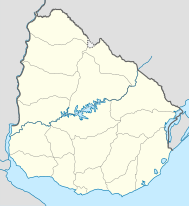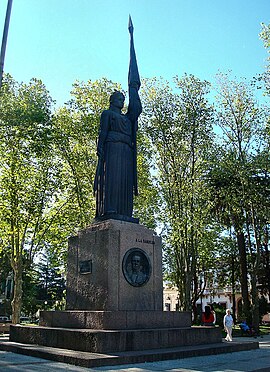Canelones (city)
| Canelones | ||
|---|---|---|
|
Coordinates: 34 ° 32 ′ S , 56 ° 17 ′ W Canelones on the map of Uruguay
|
||
| Basic data | ||
| Country |
|
|
| Department | Canelones | |
| City foundation | June 10, 1782 | |
| Residents | 19,865 (2011) | |
| City insignia | ||
| Detailed data | ||
| surface | 22.83 | |
| height | 31 m | |
| Post Code | 90000 | |
| City Presidency | Dario Pimienta | |
| Website | ||
| Monument A la Bandera in Canelones | ||
Canelones is a city and a municipality in Uruguay .
location
The capital of the department of the same name, Canelones , in the south of the country, 46 km north of Montevideo , borders the left bank of the Arroyo Canelón Chico and is surrounded by the smaller towns of Paso Palomeque and Paso Espinosa . The neighboring town of Santa Lucía and the Arroyo Canelón Grande , which flows past Canelones to the north and where a reservoir extends halfway between Canelones and Paso de Pache at the Represa del Canelón Grande dam, are located just a few kilometers away to the northwest .
Residents
At the 2011 census, Canelones had 19,865 inhabitants, of which 9,400 were men and 10,465 women. For the municipality 2011 a population of 27,406 is given.
| year | Residents |
|---|---|
| 1963 | 14,185 |
| 1975 | 15,988 |
| 1985 | 17,323 |
| 1996 | 19,388 |
| 2004 | 19,631 |
| 2011 | 19,865 |
Source:
history
The village came into being when the first Galician and Canarian colonists arrived. The Canarian colonists were so important to the founding of Canelones that people still call themselves "the Canaries" to this day. In the 17th century the first settlers devoted themselves entirely to agriculture.
The city was originally founded as Villa de Nuestra Señora de Guadalupe . Miguel Laguna, the first pastor of the local parish, is seen as the founding father. In 1782, by virtue of his office, Eusebio Vidal implemented the Leyes de Indias and thus the officially announced founding of the city. The current name comes from the rivers Arroyo Canelón Chico and Arroyo Canelón Grande in the area.
From May 5, 1813 to December 8 of the same year, Artigas ' first government, formed in the "April Congress" (next to Congreso de Abril also called Congreso de Tres Cruces ), met in the city .
Since 1961 the city has been the seat of the Roman Catholic diocese of Canelones , whose cathedral is dedicated to Our Lady of Guadalupe .
In 2010 the municipality was formed. In addition to the city itself (81.4% of the population), it also includes rural regions.
economy
Canelones has the highest population density in Uruguay after Montevideo. Due to its proximity to the capital, the majority of agricultural production is located here and also creates most of the jobs.
Infrastructure
education
Canelones has established with the October 4, 1912 Barrio Centro located Liceo Departamental "Tomás Berreta" about a high school ( Liceo ). The catchment area of the school includes the city area and the surrounding area.
traffic
Route 5 , Route 11 and Route 64 run through the city . In addition, coming from Montevideo, the city is crossed by a railway line towards San José and towards Florida .
Culture
Canelones houses the “Nuestra Señora de Guadalupe” cathedral, which has had a mechanical organ made in Savona, Italy , since 1900 , declared a Monumento Nacional . The cathedral itself was built in 1834 and, along with the Plaza Principal, is one of the most important points within the city.
The cultural institutions of the department capital include the Museo Histórico Departamental Juan Spikerman and the Museo Arqueológico Prof. Antonio Taddei as well as the Teatro Colón - Conservatorio Municipal and the Teatro Politeama .
City administration
Mayor ( Alcalde ) of Canelones is Darío Pimienta ( Frente Amplio ).
Town twinning
-
 Santa Fe , Argentina
Santa Fe , Argentina
sons and daughters of the town
- Joaquín Suárez (1781–1868), politician
- Jacinto Callero (* 1945), football player
- Beto Satragni (1955–2010), composer and bassist
- Rubén Umpiérrez (* 1956), Uruguayan-French football player and coach
- Rubén Plaza (1959–2012), football player
- Robert Siboldi (* 1965), soccer player and coach
- Hugo Guerra (1966-2018), football player
- Sandro Franco (* 1969), football player
- Álvaro González (* 1973), football player
- Diego Lugano (* 1980), football player
- Alejandro Reyes (* 1984), football player
- Mario Rizotto (* 1984), soccer player
- Felipe Laurino (* 1989), football player
- Matías Zunino (* 1990), football player
- Carlos Núñez (* 1992), football player
- Facundo Peraza (* 1992), football player
- Damián Eroza (* 1993), football player
- Agustín Peraza (* 1994), football player
- Emiliano Ghan (born 1995), football player
Web links
Individual evidence
- ^ Municipio Digital - Canelones , accessed April 26, 2019
- ↑ Image of Embalse Canelon Grande Paso Francos
- ↑ Image of the Represa de Canelon Grande ( page no longer available , search in web archives ) Info: The link was automatically marked as defective. Please check the link according to the instructions and then remove this notice.
- ↑ Statistical data from the Instituto Nacional de Estadística de Uruguay , accessed on October 31, 2013
- ↑ Observatorio Territorio Uruguay - OPP: Canelones , accessed April 26, 2019
- ↑ Statistical data of the Instituto Nacional de Estadística de Uruguay 1963-1996 (DOC file; 172 kB)
- ↑ Statistical data of the Instituto Nacional de Estadística de Uruguay (PDF; 603 kB)
- ↑ a b La Virgen de Guadalupe y la Catedral de Canelones (Spanish)
- ↑ "Reseña histórica del Departamento de Canelones" (Spanish)
- ↑ Liceos del Uruguay (Spanish) (PDF; 6.94 MB), accessed on February 29, 2012
- ↑ Canelones Capital at www.turismoenuruguay.com.uy (Spanish)
- ↑ Description of the city on www.imcanelones.gub.uy (Spanish)
- ^ Official website of the Municipio Canelones , accessed on April 26, 2019
- ↑ Santa Fe - Ciudades Hermanadas website , accessed April 26, 2019



